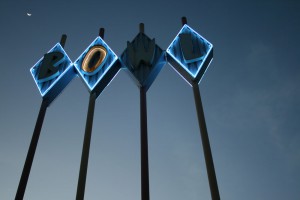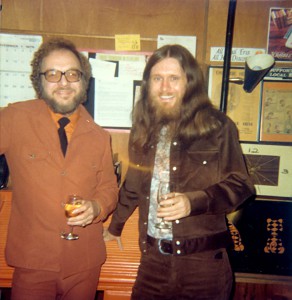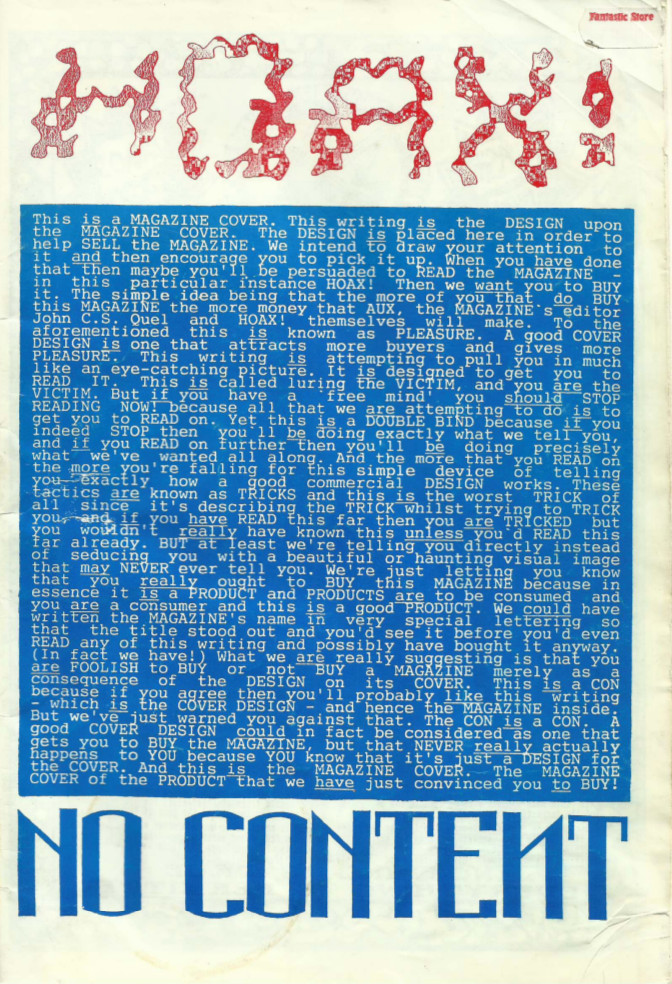
“To follow is the third version of ‘A Legacy of Sex, Death and Charisma’ written by myself and Camden Benares around 1988. The first version was written by Camden and was significantly different, featuring a Marilyn Monroe film festival. Brother Ball was the main protagonist and it featured Fitzgerald Baker in a much different situation. The original story was written in the late Seventies before we had completed the first book of our opus, The Crying Clown Celebration.
We had a much better understanding of our characters after completing The Book of Phillip and our intention was to sell this short story to one of the SF magazines and use it to promote the novel. Unfortunately, it never sold. So there it is 25 years later. I still believe it’s one of the best things we ever wrote.”
—John F. Carr,
Boalsburg, Pennsylvania,
Sept. 2015

Camden Benares & John F. Carr
Copyright 2010 by John F. Carr
Fitzgerald Baker may well have been conceived in an act of erotic terrorism. That was what his mother had told him and it can be verified that Felix Pendragon initiated her into the League of Erotic Terrorists. However, she was also known to sacrifice truth for entertainment in most of what she said. Her story of spitting the ejaculation into a hypodermic and using the needle to perforate her hymen to accomplish a virgin birth was entirely fictional. But Fitz hadn’t come to a lifestyle crisis counselor because his mother was an artist at the whiff riff.
He was thirty-eight years old and had already come to terms with his mother’s reality according to the genealogy chart he handed me:
| John Fitzgerald Kennedy 1917 to 1963 Assassinated |
Norma Jean Baker alias N.J. Mortenson alias Marilyn Monroe 1926 to 1962 probable suicide |
| Gene Fitzgerald Baker Born between 1958 & 1961 Assassinated in 2002 (see note #1) |
Zelda Harrington birth date unknown Assassinated in 2002 (see note #2) |
| Zach Fitzgerald Baker 2003 to 2052 |
Mary Gulik 2033 (?) — (see notes #3 & #4) |
| Fitzgerald Felix Baker 2050 — |
|
Notes:
- The allegation that Gene F. Baker’s parents were J. F. Kennedy and Marilyn Monroe cannot be proved or disproved.
- There is no verifiable background data on Zelda Harrington. Mary Gulik has said that the name was an alias for erotic terrorist Robin Jefferson. Zelda Harrington was pregnant when she disappeared immediately after her husband’s death.
- The woman who took the name Mary Gulik was approximately two years old when left at a Daughters of Demeter lodge.
- Mary Gulik is an unreliable source of information. She once said, “Relating the mundane truth is a failure of the imagination.”
Baker had made the appointment through my answering service. His actual words as recorded on the thread spool were, “My name is Fitzgerald Baker. I want an appointment with Counselor Wendell as soon as possible. He was recommended to me by Clyde Burbank, my partner in the architectural firm of Burbank and Baker. Prior to my appointment, I wish for Counselor Wendell to see the head thread, The Crying Clown Rites. Any expenses in connection with the viewing may be charged to my account.”
As I was waiting for him to arrive, sitting at my console watching the movements of a free fall mime troupe on the holly, the control panel emitted a low chime and showed the flashing light that indicated a visitor had entered the foyer. I punched two buttons on the keyboard. The mime troupe was instantly replaced by the three-dimensional image of a tall, youthful-looking man wearing a sheen suit of metallic blue and gold that fit smoothly over his well-muscled frame.
As he came closer, I looked for signs of strain on the face framed by shingle-cut, shoulder length, chestnut brown hair. When his face was nearer the camera, red fatigue lines showed around the blue irises of his eyes. Beneath the straight nose there was a full moustache that partially obscured the set line of his mouth. The movements he made as he reached into his pocket showed that he was under a strain and putting effort into controlling it.
His hand emerged from his pocket with a key card which he held against the scanner. I looked at it on the monitor and read:
Fitzgerald Felix Baker
ICID: 0-915904-24-1
I pressed the control that opened the first set of doors. Fitz went through them, waited for them to close and then stepped through the second door when I punched the release. His first words on entering my office were: “Clyde Burbank recommends you highly. Your success in handling his success crisis was very effective. He thinks you can help me with my problems.”
“Sit down and tell me about them.”
He handed me his genealogy chart and asked, “Have you seen The Crying Clown Rites?”
“Yes. I have a copy here which we can view on the holly if that is desirable.”
“No. I don’t want to see it again. That’s why I asked you to see it before this appointment. Take a look at the chart I gave you and you’ll know almost as much about my origins as I do. Then we’ll get into my present problems.”
I scanned the chart, then read it quickly, finding no connection at least, no apparent connection between it and the thread that detailed the rites of passage into manhood within an obscure, macho enclave.
When I looked up, Fitz said, “As you’ve just read, my background connects me to the old Kennedy clan. That chart doesn’t show the aunts, uncles and cousins whose lives ended by assassination, suicide or disappearance. I don’t know whether I’m going to live long enough to develop a satisfactory lifestyle or not.”
“Do you think that someone is trying to kill you?”
“I don’t know. Lately, I’ve had the feeling several times that I was being monitored.”
“Have you considered hiring a security service?”
“Yes, but I don’t want to do that if there are any good alternatives. I would hate to be imprisoned by my own ancestry.”
“Have there been attempts on your life in the past? You could be being monitored for some other reason than assassination.”
“There haven’t been any attempts in the past several years, but before then there were two definite attempts and some close calls in near accidents that could have been planned by an unknown group or individual. That may sound paranoid to you. Let me show you that if it is paranoia, it has a solid foundation.”
Fitz pulled open the presfast at the top of his suit and showed me a scar that looked like a laser gun crease, dark, puckered skin next to a gold medallion on a chain. Then he said, “That scar was made by an assassin at a political rally on the University of California Berkeley campus. She escaped in the crowd and was never captured or identified. I gave up my political science major, transferred to UCLA and became an architect.”
Fitz seemed lost in memories for a minute. I asked, “What’s the significance of that talisman around your neck?”
He pulled the metal and chain over his head and handed it to me. It looked and felt like gold. The lines of the design were worn but recognizable as a boat. Sunken letters on the back spelled out Kennedy. Fitz said, “My mother told me that it is a replica of the boat my great-grandfather commanded during Hitler’s war. She said that he gave it to Marilyn Monroe and it’s been in our branch of the family ever since.”
“Let’s get back to your present problems and why you wanted me to see The Crying Clown Rites.”
“I wanted you to know a little about my background so you can understand how seriously that head thread affected me. In the thrill kill scene, I saw the hunters as all the assassins lurking around my family tree and I identified with the victim. Maybe I should have left then, but I stayed. When they got to the actual initiation rites and one initiate said, ‘I don’t have to go through this: I can die,’ and then tries to commit suicide by holding his breath. That’s when I ran out of the theater, vomited in the street, again in the vault station lav and for a third time when I got home.”
“What did you do then?”
“I took an Oblivion Blue. When I woke up, I made the appointment with you.”
“Do you have any problems in your business life?”
“Only an increasing feeling of encroaching boredom across the entire spectrum of architecture.”
“Sexual relations?”
“Nothing enduring. I find casual encounters adequate to meet my present needs.”
“What is your domestic situation?”
“I live alone.”
“Would you describe yourself as lonely?”
“Not exactly. There are people and activities in my life, but not enough meaning, not enough significance. I’m tired of transient personalities, throwaway relationships and plug-in lifestyles. By objective standards I’m successful, but I’m almost middle aged and bored with the future I see for me. The Crying Clown Rites was the input that caused an overload. Not only did I feel that I had missed something, failed to complete my personal rites of personhood, but I found myself simultaneously worried about assassination and suicide. I don’t know if I’m going to live long enough to come to terms with my own death wish.”
Fitz was showing signs of agitation which meant to me that I should bring this session to a close. I asked, “Do you have any religious or ethical prohibitions concerning suicide?”
“No. I’ve never been captured by any ideology that emphasized negatives and prohibitions.”
“Then the next step in resolving your crisis is to discover whether you wish to live or die. I’ll need a diagnostic analysis and your approval of the procedures.”
“I don’t give a damn about the procedures. I’m very interested in the answer to that question. What do I do and when do we start?”
“Take off your clothes and step into the diagnostic analyzer.”
Fitz shed his sheen suit and entered the white cubical. I keyed in the program for maximum information. In a few minutes I would have a complete medical file on Fitzgerald Baker.
When Fitz emerged dressed from the cleanser, I said, “It will take about three days to make preparations. Can you be here at eleven hundred on Friday?”
Fitz confirmed the appointment and left. I fed the thread I’d made of the session into the computer for stress analysis, punched in a request for full information on John Fitzgerald Kennedy and began to plan the next session with Fitz.
At the end of my working day, I sat down at the console to clear my head for the evening’s activities. I lit the candle in the custom holder, watched it as it flickered. The sensor in the rim of the holder used the heat as energy to push the candle higher each time the flame dipped below the rim. I punched the key for the candle exercise thread and concentrated on the candle flame as my own voice at random intervals asked me, “Where are you?”
When I reached the right space, I left the office, and Fitz’s problems with it, until the next day.
All my preparations were complete when Fitz arrived promptly at eleven hundred on Friday. I ushered him into the green room and asked, “Have you ever experienced pharmodrama?”
“No. My only knowledge of it comes from the holly.”
“I want to explain a little about it so that you will focus on the experience instead of on the techniques used to produce it. Basically, pharmodrama uses pharmaceuticals and technology in combination to create a drama in which you will be the central character. The drug mixture that I’ll give you is adjusted for your chemistry. The drama will take place while we’re sitting in these recliners with the sensor skullcaps on.
Fitz interrupted to ask, “Will we both be having the same experience?”
“Not exactly. You are going to be the star; I’m going to see the same scenes but I will tuned in to your reactions to the experience.”
“Is this going to tell you whether I wish to live or die?”
“It’s going to tell both of us.”
“Good, what else do I need to know before we start?”
“When the drugs begin taking effect, you will become aware of everything that you think of as you slipping away and may be somewhat surprised to discover that you still exist when all that represents you to you is gone. As soon as your reactions to that state stabilize, an identity thread will be fed into your brain via the skull cap to create the temporary persona that you will be for the drama.
“I’ll be outside of your own awareness but tuned into everything that, you experience, ready to handle any problems if there are any.”
Fitz said, “I’m ready.” He sat down in the recliner. I injected the drug mixture into him, adjusted the controls so that only I could read the monitor output and waited for the temporary chemical dissolution of the facade that Fitz presented to the world.
When the readout confirmed that Fitz was ready, I fed the identity thread into his skullcap. As soon as positive pickup registered, I took the maximum dose of Empathy Plus for someone with my metabolism and empathy quotient and waited.
As the Empathy Plus coursed through my blood stream, I could feel my own personality receding, enabling me to identify with the star of the drama I was recreating, a drama based on some of the known facts in an historical event. I put on my skullcap and verified that I could detect and empathize with the thoughts and feelings of my client, who now believed that his name is John Fitzgerald Kennedy and that he is the thirty-fifth president of the United States.
The drama began with the voice of a reporter coming directly into our brains, a voice with most of the regional accent lost through announcer’s training but the rhythm of the speech was definitely American Southwest and the hint of a Texas drawl hovered over the words like a hummingbird checking out a flowering plant. At some deep level I knew it was the voice of an actor hired by me to record the message he was delivering, but within the pharmodrama framework, I was hearing it as Fitz heard it as an announcer’s voice coming out of the open-topped vehicle’s radio, saying, “For those of you who just tuned in, November 22, 1963 is a pleasant day here in Dallas, just right for a presidential motorcade. I’m here at Dealey Plaza and according to the schedule I was given, President Kennedy should be coming into sight any moment now.”
The laser beam scanner transferred my client’s thoughts via computer into my skullcap as input, thoughts that became mine as my own personality submerged and I became the pseudo John Fitzgerald Kennedy:
I was waving to the crowds, hearing them cheering, hoping that the presence of Governor John Connally and his wife in the car would help convince skeptics that I had patched up the differences between conservative and liberal factions of the Texas Democratic Party.
With the facsimile of excitement in his voice, the announcer said, “Here comes the lead motorcycles turning onto Elm Street. There is the presidential limousine now, a blue Lincoln coming this way. The President is waving to the crowds who seem very excited. The President’s wife is sitting beside him. Just in front of them, in the seat behind the driver are Texas Governor Connally and his wife. I’ve never seen the people of Dallas give anyone a more enthusiastic reception.”
Mrs. Connally turned toward me from the forward seat and smilingly said, “You can’t say the people of Dallas don’t love you, Mr. President.” As I started to smile at her in reply, there was a loud noise. I seemed to be riding the crest of a shockwave.
What’s happening? I can’t think straight. Did I have too much to drink? Never liked heavy drinking parties anyway. Remember Charley at Harvard. Always lushing it up, especially after midterms. I remember his favorite toast:
Drink it up!
Drink it up!
Drink it up!
If you die young,
What’s the diff?
The coeds will say,
As they lay you away,
“That’s a good-looking stiff.”
The shockwave hit me again. It’s that Japanese destroyer. It’s run into our starboard side. The wheel is being torn out of my grasp. My back just hit the rear of the cockpit. Somebody is saying something, but I can’t understand it. It’s Johnston saying to someone who’s moaning, “Aw, shut up. You can’t die. Only the good die young.”
That’s right, Johnston, you tell them. I can’t die now. I’m still in my twenties. Only the good die young. Like my brother Joe. Joe was good. His death made me resolve to do better. Wait a minute. Joe died in 1944 and I was on Olasana Island with Johnston in 1943. What’s going on? Time and space are closing in together. There’s blood all over Jackie’s pink suit and I hear that voice again.
The announcer’s voice continued, “Those loud noises were shots. I can’t tell whether the President has been hit or not. He’s leaning forward and his wife is bending over him as the car continues down the hill. I think that Governor Connally has been hit. It looks like he was driven downward to the floor of the car. Did you hear that noise? That was another shot.”
Last effort to make sense of this. Got to clear my head. Someone is yelling something about Parkland Hospital. I can take it all in now, all of it. That’s blood on Jackie’s suit. The crowd seems to be running in different directions, screaming, yelling and pointing. What are those People doing? They’re picking up bits of bloody bone. One has a handkerchief. It’s like with Dillinger. They’re souvenir hunters. Where’s that bone from? Is it Connally’s? He’s slumped down and looks bad. But the hair’s wrong. John’s hair doesn’t have that much color. Could it be colored by the blood? Could blood make it look that color of reddish brown? The car is going faster now and I can’t see many details. I’ve got to make sense out of all of this. The wind noise is taking all, the sounds away. I can’t understand what is being said. I can’t feel the air hitting me in the face anymore. Everything has a pink tinge to it. Am I looking at Jackie’s suit or is that blood in my eye? I can feel the pain building into another wave. It’s headed my way. Got to figure out some way to stop it. Feels like it’s going to be as bad as that pain in my back. Oh God, I understand it now, but I’m not ready. I’m only forty-six and I’m dying young.”
With learned mental effort I wrenched my own personality free from the consciousness of the pseudo John Fitzgerald Kennedy. Rapidly I phased out all the input to Fitz Baker and replaced the Dallas assassination reconstruction thread with the personality recovery program that would leave the, memory of the pharmodrama intact. While the monitor gave me visual indications that Fitz was re-becoming himself, I paid attention to my breathing, calming the intense emotional experience with concentration on the repetition of the inhalation crest and the exhalation trough.
Once the disconnection procedure was complete, Fitz, still seated in the recliner, looked toward me and said, “I want to live. I really want to live, don’t I?”
“There is no doubt in my mind. Is there any in yours?”
“No. I was him but the feelings about premature death were all mine. Do you think he felt as I did? Is it possible that our internal experience was the same?”
“It may have been, but there is no known reliable method of chronicling the unrecorded thoughts of the dead. Some of the religious groups are exploring that territory. Of course, very little of their data can be verified because of its subjective nature. Is knowing what he thought as he was dying important to you?”
“I don’t know yet. I haven’t quite recovered from the identification with him in the pharmodrama. I think I’ll go to Arlington, where he’s buried, this year and say a final goodbye to him on the anniversary of his death. Then I’ll be able to let him rest in peace, maybe we both will.”
Fitz resting in peace had an ominous connotation, reminding me of his fears of being monitored for the purpose of assassination. I said, “You might have more peace of mind if you called Max Security and have them check whether or not you’ve been monitored lately and if you have, by whom and for what purpose.”
“Is that a professional recommendation?”
“I’d recommend the same procedure to a friend.”
“Okay, I’ll do it. What else?”
“I’d like to see you again on Monday. By that time you should have the Max Security report. Why don’t we meet for brunch at the Egg Keg around 10:30? You know where it is?”
“I walked past it on my way here from the vault station. I’ll see you on Monday.”
Fitz got up from the recliner and left. That was a reassuring sign. An intense pharmodrama experience like he had just undergone tends to immobilize some of the crisis prone for up to forty-eight hours.
On Monday, Fitz was in the anteroom of the Egg Keg when I arrived. I turned on my ever present pocket recorder before he said his first words to me, which were, “I got the Max Security report: I was being monitored about ten days ago.”
“By whom?”
“The government. According to the report, I’m one of the architects being considered for a government project. That is a waste of time and effort on their part. I would never attempt to do creative work for a bureaucracy. It would drive me bureau crazy.”
We went into the restaurant, showed our key cards to the scanner, punched out our orders on the menu terminals and, in a few minutes were eating our omelets, mine with truffles and Fitz’s with mushrooms, and drinking light draft beer from chilled crystal mugs. When we were finished, I asked Fitz if he were willing to vault somewhere else for coffee. (A small minority of humans get nauseous from teleporting on a full stomach. Fitz was evidently not one of them.)
“Do you have a particular place you prefer?” asked Fitz.
“The coffee bar in the pyramound at Calm Springs, if that’s acceptable to you.”
“Of course it’s all right with me. Clyde was certain that you would make yourself familiar with my work as part of the counseling, but then my partner is right about most things. I imagine that we’ll talk about architecture over coffee. I’m ready.”
We left the Egg Keg and began walking toward the vault station, two affluent members of a mobile society where only a minority lived at the misery level. The combination of structural glass and spring sunlight along our route occasionally flashed our reflections back at us two men matching their walking pace to each other, Fitz a few centimeters taller than me, his prominent Adam’s apple and depilated chin contrasting with my full, short, black beard, his copper-colored sheen suit harmonizing with my rust jump suit. Both of our minds were on the same subject. That was confirmed when Fitz asked, “Did my partner tell you why he decided to become an architect.”
“No. He mentioned that his family encouraged him.”
“It was something that his grandfather told him. Clyde asked his grandfather why he had moved to California. The old man told him, ‘I was born in New York. My parents were born in New York. All four of my grandparents were born in New York. When my son was born, also in New York, I couldn’t wait for him to get old enough to appreciate his cultural heritage. By the time he was, we were living in a new building on the other side of the city. I took him back to the old neighborhood to give him an appreciation of the past. All of the buildings were gone, replaced by newer ones. Not a single place where any member of our family ever lived before was still standing. What heritage was there to share? None. I talked it over with your grandmother and your father and we decided to come to California. After we’d been here for a few years, I saw the same thing happening here, new buildings for old. By this time your father had frequently demonstrated a talent for taking things apart, so I encouraged him to go into the demolition business, but you shouldn’t go into your father’s business, Clyde. You are creative. You should create buildings that will last long enough for your grandchildren to see them.’ So Clyde Burbank became an architect.”
“You remember that story well. Can you tell me what made it important to you?”
We walked about another thirty meters before Fitz ended his frown of concentration and said, “I never met either of my grandfathers and I never got that kind of advice. I became an architect by a different path but with the same kind of spirit that Clyde’s grandfather inspired in him. That’s what the study of architecture created in me. That’s probably what Clyde recognized in my designs that caused him to ask me to become his partner.”
The vault station was just ahead of us. As we entered an assorted party of six, all wearing the faddish after-midnight makeup of Chinese red, emerged, talking about a festival that they had evidently attended in Hong Kong. They headed for the cleansers as Fitz and I went to the terminals, thumb pressed our key cards to the scanners, punched in our destination, and went to our respective booths.
Inside the darkened cubicle, I felt the sensations that teleportation always induces in me: the bubbling of my blood through my veins and arteries as if champagne were circulating in my body, the tingling of my skin as my brain recorded the feeling of thousands of small brushes gently stimulating the surface that connected me to the rest of the world, the lightless flash as I was transported via the energy force lines of the Earth to the foothills of the San Bernardino mountains.
I emerged from a similar cubical into the Calm Springs vault station, which differed from every other vault station only in its signs. Automatically, although if I had thought about it I would have realized that I hadn’t changed time zones, I checked my watch against the clock showing local time.
Fitz, having, of course, arrived at the same time, saw me look at my watch and said, “Local time is 11:48.” As far as I could tell he hadn’t glanced at the clock and he wasn’t wearing a visible watch. I asked, “What told you the correct time?”
“It’s one of my tricks. I always know what time it is wherever I am.”
“How did you learn that?”
“I’ve always had that ability.”
“Can you teach it to me?”
“I don’t know how to teach it to anyone, but if I ever learn how it’s done, I’ll tell you.”
As we left the vault station I saw the pyramound about two kilometers away. I had seen it before but saw it with new eyes now that I was standing beside the man who designed it. The hemispherical top was the mound that collected the maximum solar energy for utilization in the modules below which were assembled in the form of an inverted pyramid. Each outside corner was supported by a tubular structure that housed both a lift and a baffled gravity drop which could be used for humans and equipment.
The structure was visually appealing and blended harmoniously with the nearby foothills and mountains. With unspoken agreement Fitz and I boarded the tram that ran from the vault station to the building. Moving closer to the pyramound changed the visual, but not the mental, perspective from which I viewed it.
Fitz was looking off into the distance, perhaps at the tops of the mountains. I got his attention by saying, “I compliment you on your achievement.”
“Thank you. It’s one of my better efforts.”
“It looks like it was specifically designed for this spot, was it?”
“Yes, this was where the dowser found the water, using a bent coat hanger as an indicator.”
As we neared the first of the lift/drop tubes, I asked Fitz if he had invented the concept. He said, “Oh, no. The design of powered lifts and gravity drops have both been around for a while. I just modified them for the pyramound. When the techies were responsible for most architectural design, what John Brunner called ‘shitabrick phase architecture,’ there were no gravity drops, which meant that a power failure created instant disaster for the people but no damage to the building it was the same kind of ignorance in action that produced the neutron bomb and a history of human warfare.”
Proceeding to the terrace, Fitz and I continued our discussion. While getting coffee from the automatic dispenser, Fitz asked, “Can you name one architect from the last century who has an admired work still standing now?”
“Wright.”
“Right. Can you name one of his works that you’ve seen?”
“The Swedenborg glass chapel at Portuguese Bend.”
“You are hereby awarded two points, would you like to try for four?”
“No, I’d rather concede that most of twentieth century architecture was uninspired and not well adapted to human needs and values.”
We took our coffee cups to a nearby table with a view of the mountains. I mentally reviewed what Fitz had said previously about architecture before speaking again.
“You mentioned at our first meeting that you were bored with architecture. Would you like to expand on that thought?”
“I’ve established myself as an architect. I’m not plugged into any energy drains that require me to work and I’ve accomplished the architectural goals that I set for myself. This building, with its replaceable modules, will probably survive longer than I will. What architect could ask for more in a world where change seems to be the major constant? I could. I wanted to create a building that would be an artistic tribute to those changes, an edifice to edify humanity, a temple of humanity. Do you know the project that I’m telling about?”
“Yes, your design of the Pantheon of Prophets. It’s a great achievement.”
“I’ve completed it. It’s opening next week and I’m so bored with the entire project that I’ve been looking for some excuse to avoid attending the dedication. Do you know what most architects are working on now? Huburbs. That’s like reinventing the wheel. Of course each one is different, but every one has the hub center which usually is a vault station. Every one has a variety of structures in the spokes and rim. Some of them make interesting or practical use of the space between the spokes. The only major question of design is what style: Egyptian, Mesopotamian, Persian, Greek, Roman, medieval, renaissance, academic, baroque, functionalism, technic or some combination of any number. If I had to devote the rest of my life to that kind of work I would feel empty. I don’t intend to suffer that kind of professional deformation.”
“I understand what you mean.”
“Perhaps you do vicariously, but what would you do if you were experiencing a lifestyle crisis? Go to another lifestyle crisis counselor or handle it yourself? Do counselors have the same kind of crises as other people?”
“Some of them do, but the two main occupational hazards are suicide and insanity, the traditional refuges from inescapable reality.”
Fitz finished his coffee in a final swallow before asking, “If you felt near an overload now, what would you do?”
“Meditate, exercise or vault to a place where I could change my head around.”
“Let’s go to one of those places, one with a minimum of architecture.”
We took the tram back to the station, vaulted to Pasadena and walked to the Western Zen Gardens, where there were cacti, rocks and sand enclosed within a perimeter of trees that blocked all buildings from view. A carved wooden plaque, beside the gate read:
The sound of Zen is the sound of rain.
The taste of Zen is the taste of tea.
The feel of Zen is the feel of the wind.
The smell of Zen is the smell of the sea.
Fitz and I walked quietly through the garden until we came to the arced mound where an assorted group of people were sitting cross-legged on the ridge, some of them meditating, others watching the Zen Shaman as he raked gently flowing curves in the sand. When the Shaman finished, he turned to the seated gathering and said, “I feel that it is question and answer time. Any of you may ask any question. I will answer it to my own satisfaction which may not be the satisfactory answer for you. Bear in mind that I speak for no one but myself and that I am not here to debate philosophical or theological points. Who has a question?”
A serious looking young man, halfway between puberty and full physical growth, asked, “How can I atone for original sin?”
The Shaman replied, “There is no original sin and therefore no atonement is required. All of us are born without sin, living Buddha’s full of Zen.”
A balding man in expensive clothes asked, “Why does the quality of life seem to decrease as I grow older?”
“Welcome to the here and now,” said the Shaman. “Everything that you have experienced has been necessary to get you to where you now are. If you think that you have ever been in a better place, stop looking backwards and face the direction in which you are going.”
The balding man responded with, “What will you do if someone asks you a question you can’t answer?”
With no show of surprise, the Zen Shaman answered, “In Zen Buddhism there is a device known as a koan, which is a paradox or seemingly unanswerable question, used for meditation. If I am asked such a question, I shall use it as a koan.”
An attractive brown-skinned woman of less than thirty years asked, “How can I resolve problems of morality?”
“Any code of morality is formed by abstracting from nature and creating a guide to behavior. Such guides are useful to many people, but they become unpleasant tools if they are used to attempt to control the behavior of others. Your morals are for you alone. If they require the belief of others, they will frequently conflict with the reality you experience. Never let your sense of morals prevent, you from doing what you perceive as right.”
A robed figure of indeterminate age and sex asked, “What makes you think you have all the answers?”
Looking toward the speaker, the Shaman replied, “I don’t have all the answers because there are many more answers than questions. For instance, the question, ‘Where have you been?’ has an incredible variety of possible answers from any one person. The answer to the query, ‘What am I seeking?’ differs from individual to individual. The person who has an answer for every question doesn’t have to know all the answers.”
A middle aged woman asked, “What is Zen and what is its purpose?”
The Shaman replied, “Zen is the radical approach to clarifying and liberating consciousness, a way to help create the experience of Buddha that state of enlightenment in which you and your actions are one.”
Fitz got the Shaman’s attention and asked, “Do you believe in any god?”
“I believe in a cosmic consciousness that could be defined as a deity, but belief in a god is not necessarily essential to becoming one with your experience unless you want a personal relationship with a god.”
A restless prepube with shoulder-length hair as black as mine asked, “What is the secret of Zen?”
“Zen has no secrets,” said the Shaman. “Are there-any other questions?”
No one responded, The Shaman, inclined his head toward the gathering, said, “You are the Buddha,” picked up his rake and walked down the garden path. Some of the people remained, but others began to leave, Fitz and I, by unspoken agreement, among them.
Just before we reached the gate posts from which no gate had ever hung, Fitz stopped to read the haiku-type poem there:
With nothing to do,
Liberation’s journey begins
With nowhere to go.
I waited patiently while Fitz pondered that paradox for several minutes. When he had stood there longer than necessary to commit the three lines to memory, he turned to me and said, “I’m going to attend the dedication ceremony for the Pantheon of Prophets. Then I’m going to stop designing buildings, maybe just for a while, maybe for the rest of my life. I’ve concentrated on my profession and neglected my own spiritual development in the process. It’s time for me to take a sabbatical.”
“Call me if you need additional counseling, or even if you don’t. I’d like to know where your journey takes you.”
Fitz agreed to do so. Then we came to the vault station and went our separate ways, for a while.
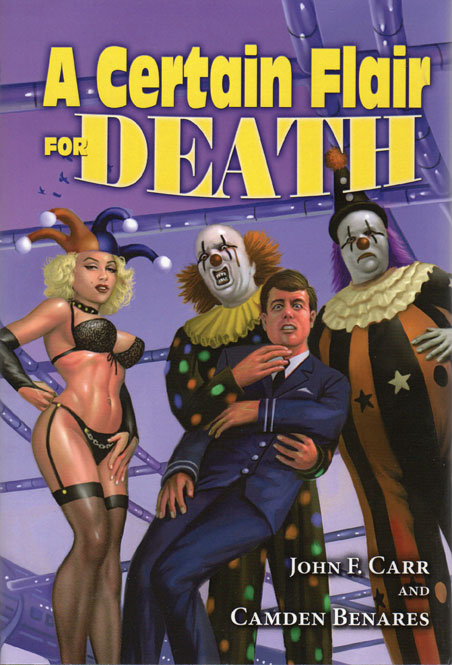
by John F. Carr
and Camden Benares.
Available on Amazon Kindle and in Hardcover.


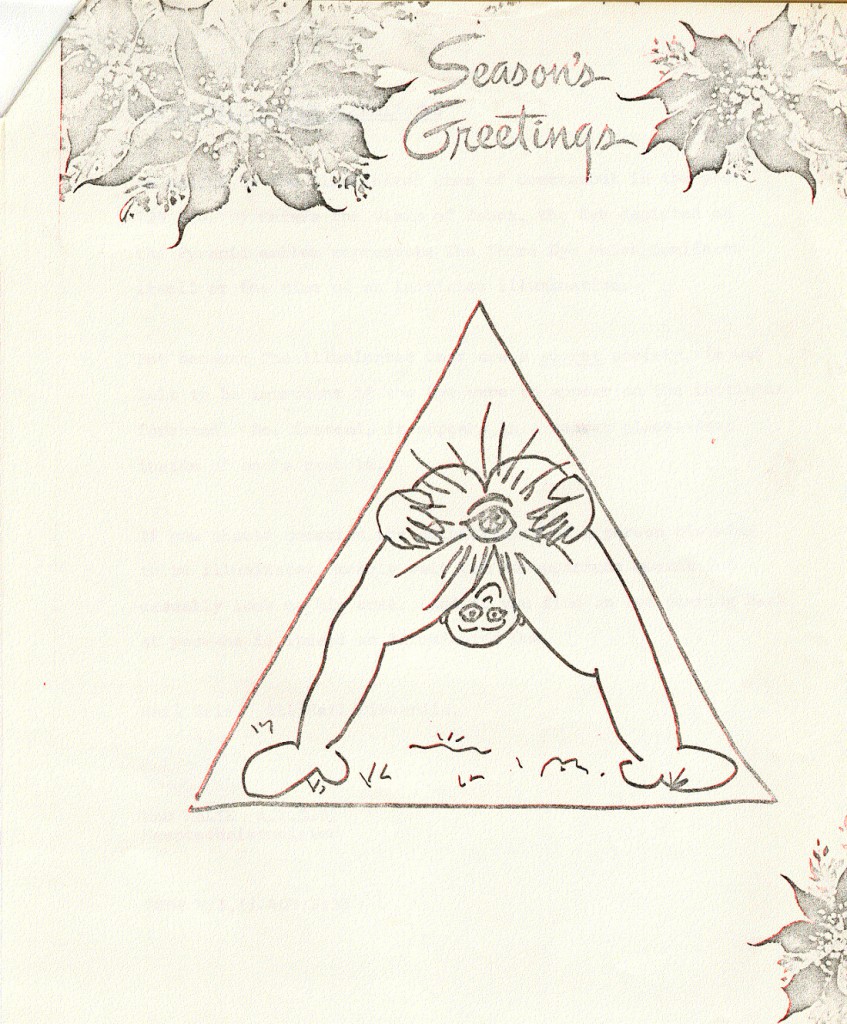

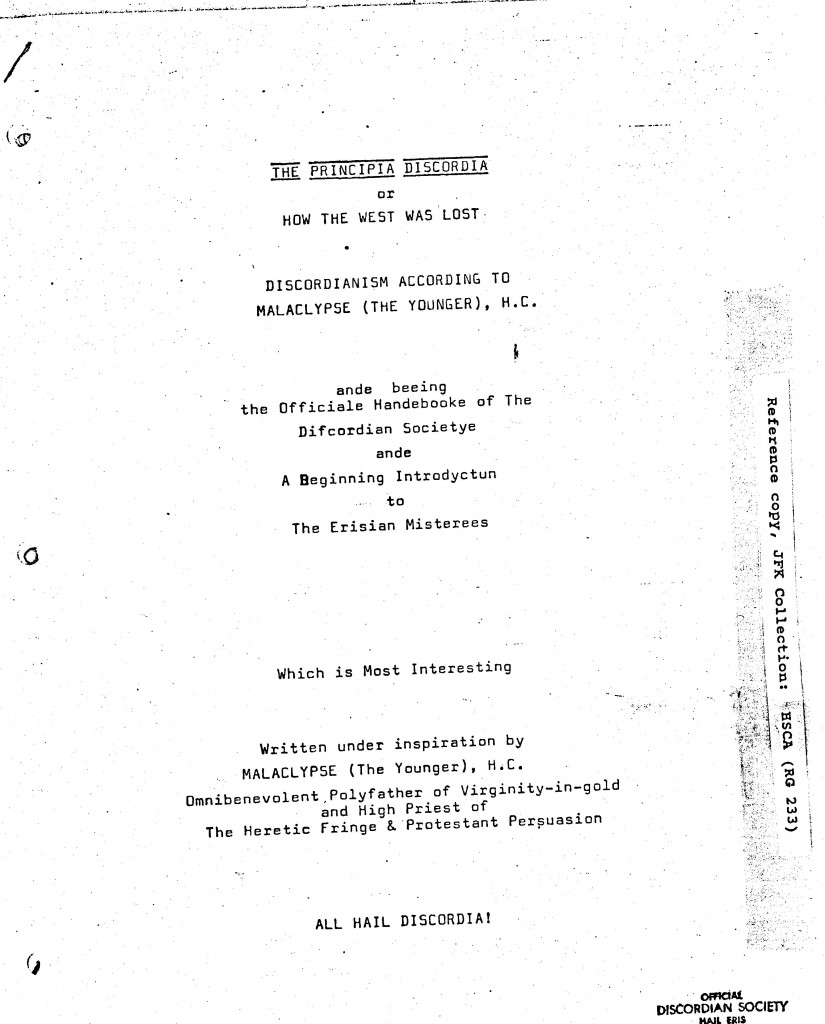
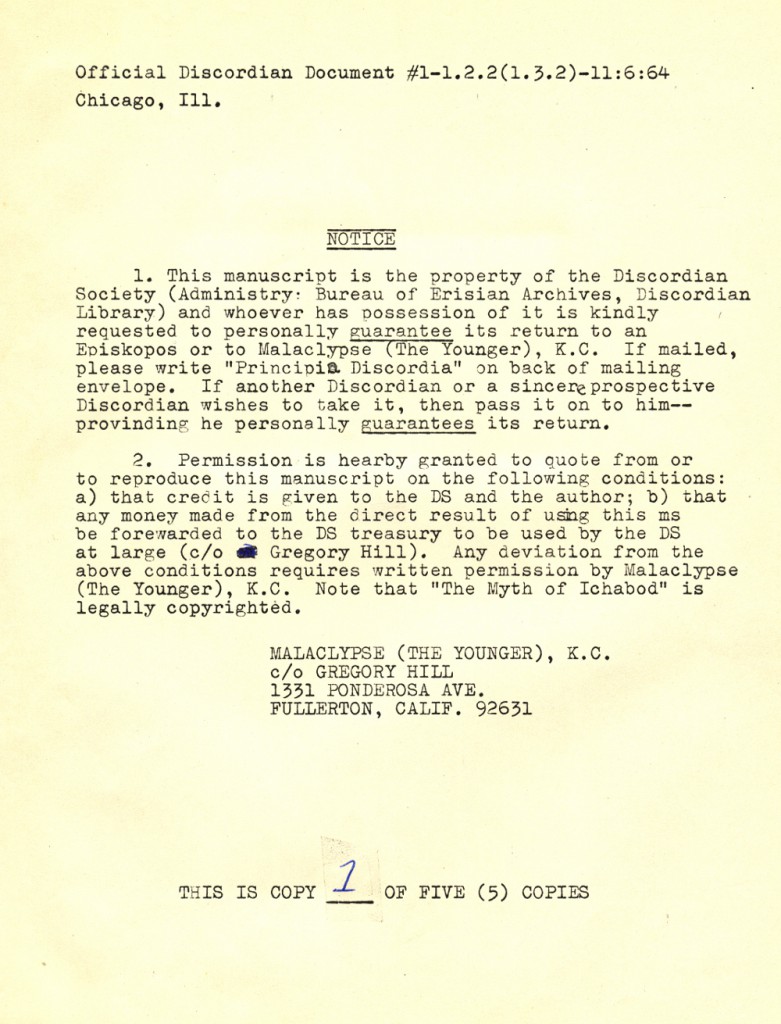


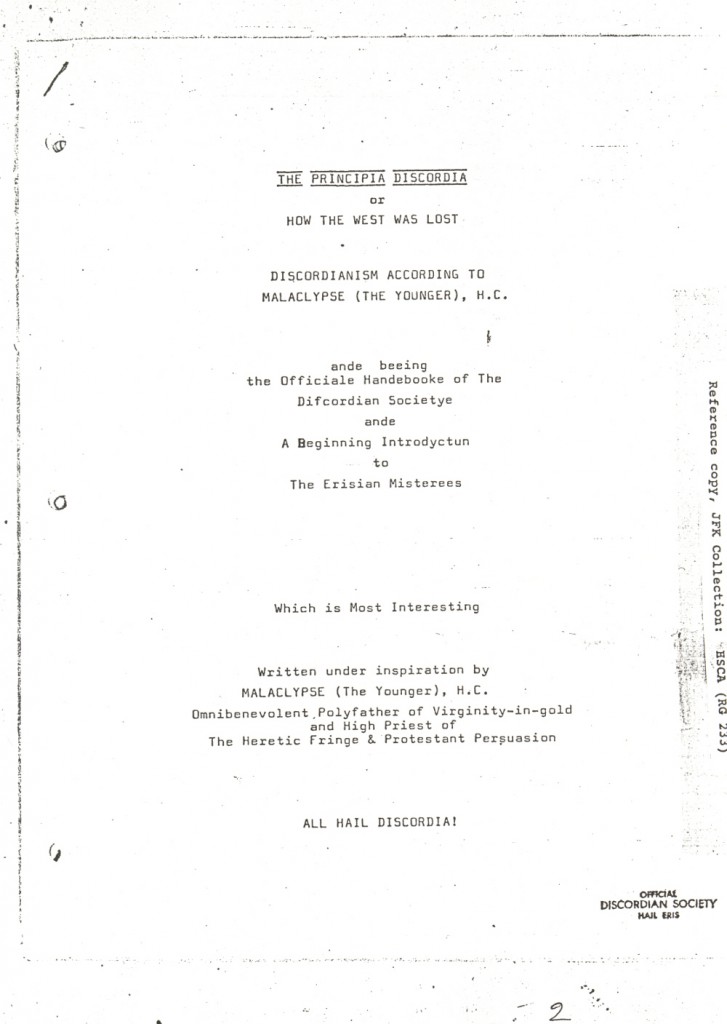
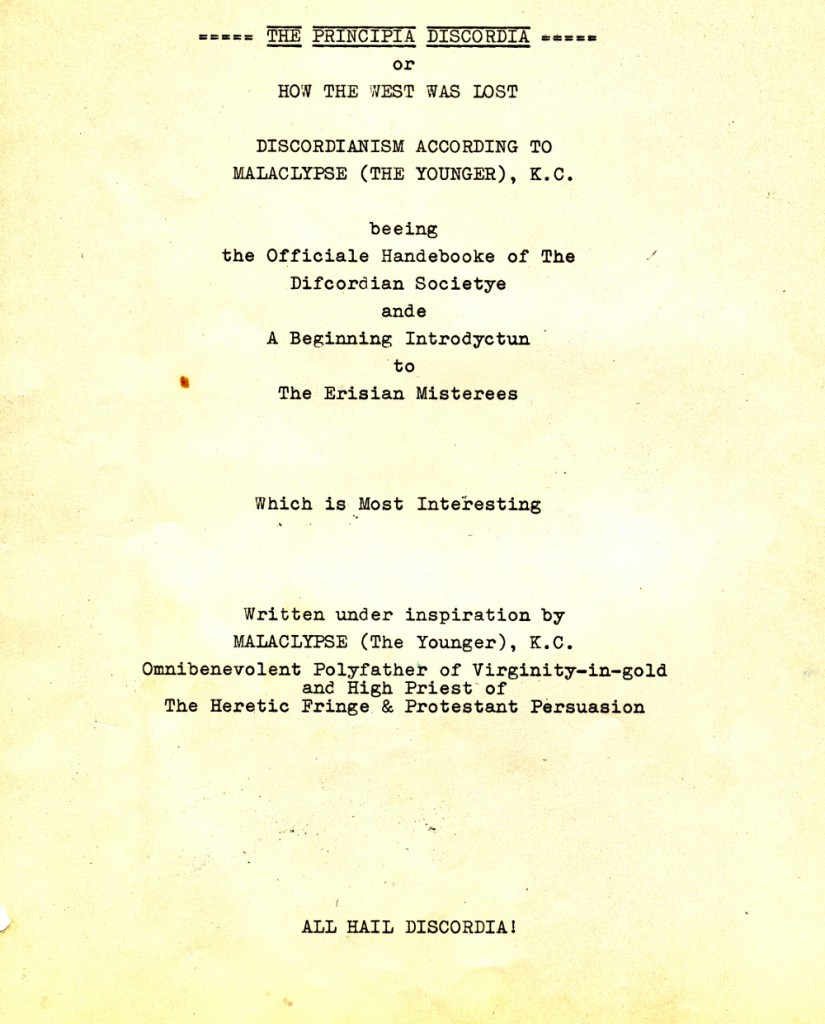
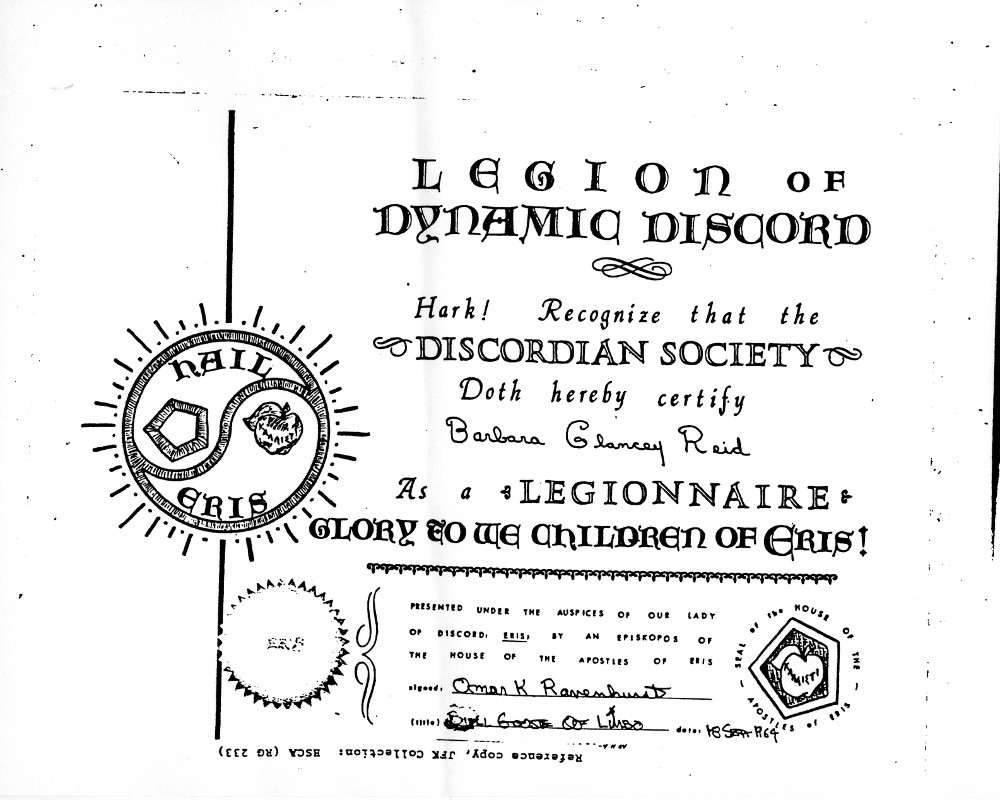

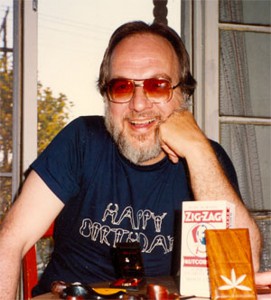
 This day is the anniversary of Adam Weishaupt’s founding of the
This day is the anniversary of Adam Weishaupt’s founding of the 


